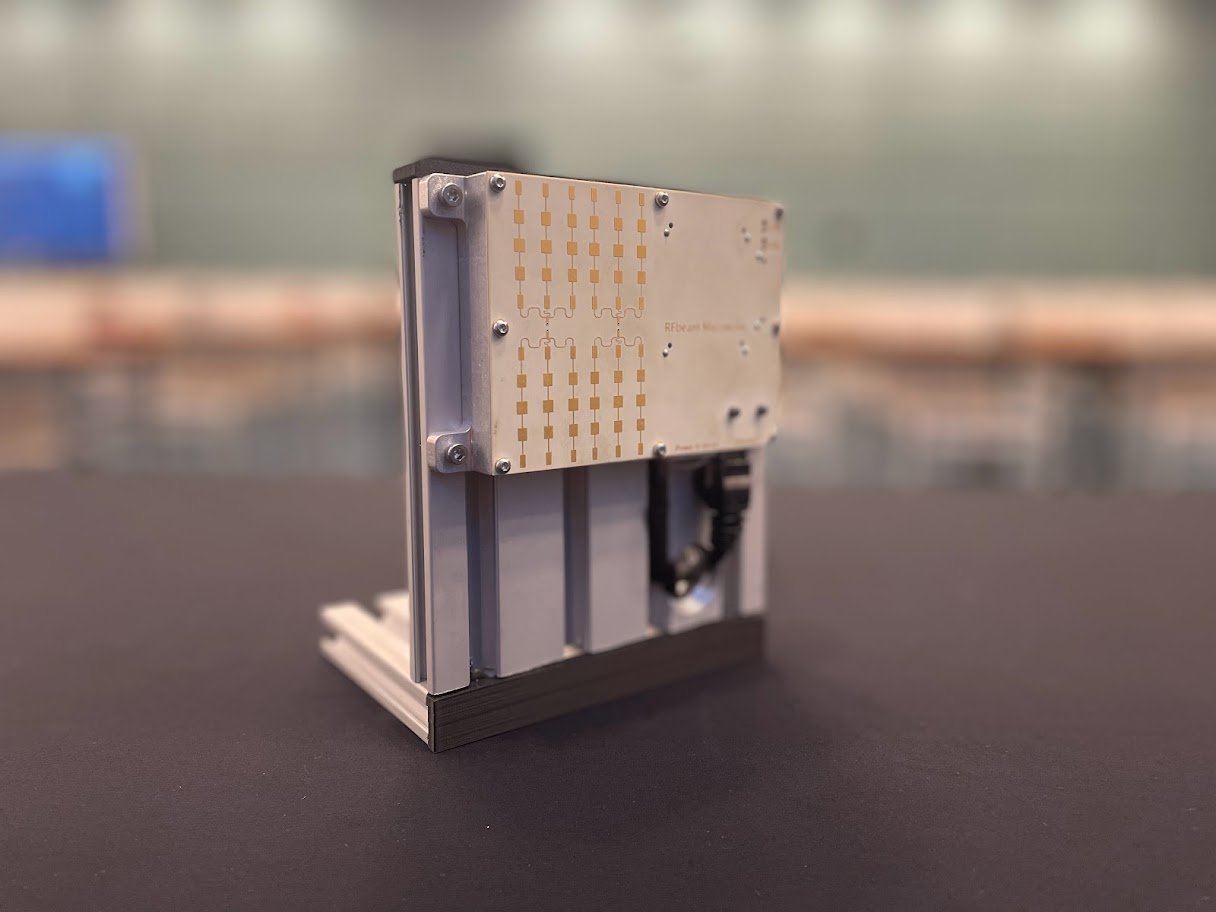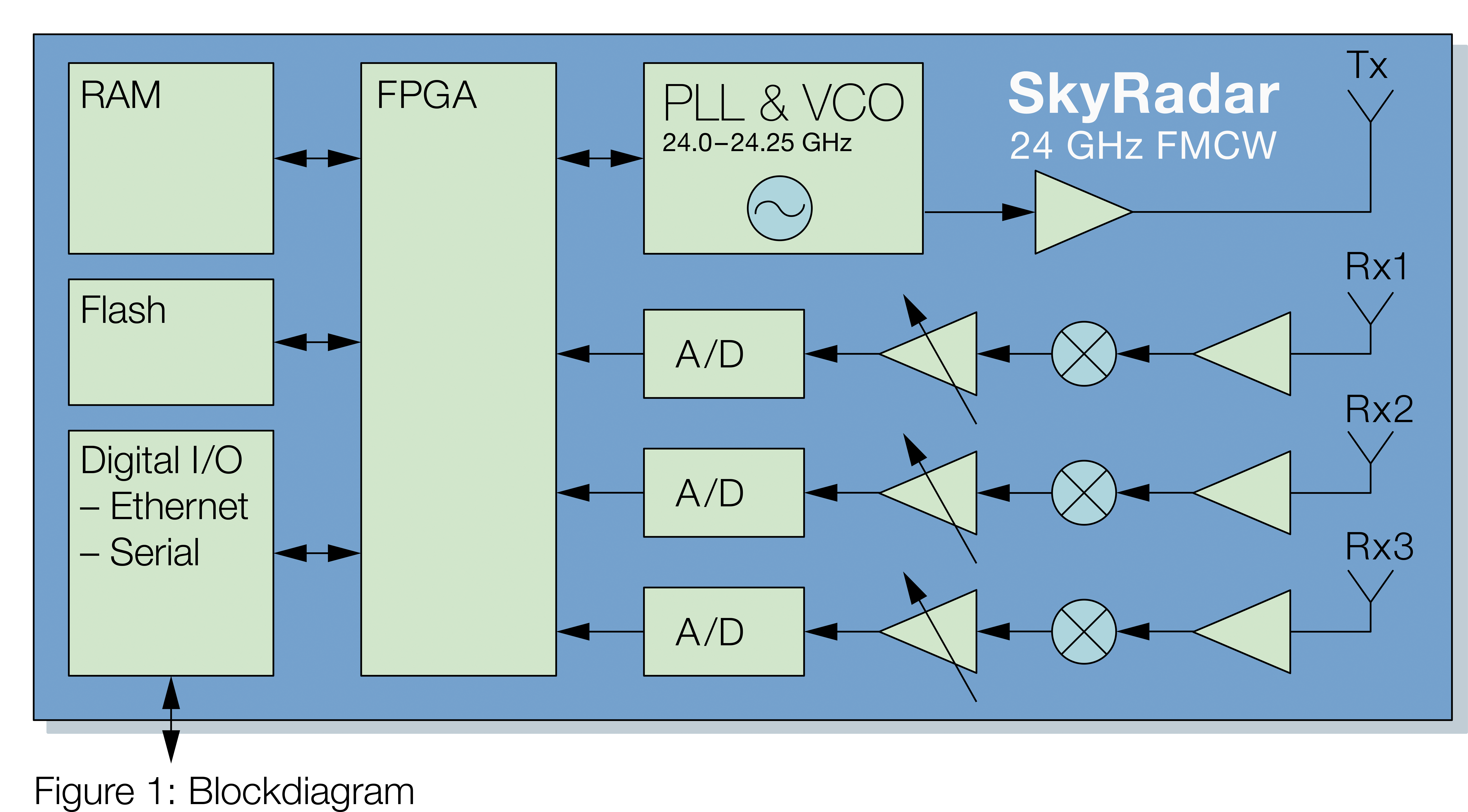At the heart of the system is an FMCW transceiver. A variable trigger wave allows to generate also a Frequency Shift Key Mode. In addition, the transceiver can operate in Doppler mode. The transmitter can emit very short pulses through the antenna and monitor the reflected pulses. The pulses are reflected of fixed objects (buildings, trees…) and moving objects (cars, people…) which pass the antenna beam. The FMCW Base Module provides the opportunity to study Doppler effects.
The signals are digitally processed using a Digital Signal Processor (DSP), data is visualized through the analysis and visualization software SkyRadar FreeScopes.
The system in its standard configuration has a range up to 50 m (detecting objects of the size of a car). The standard version comes with an array antenna.

SkyRadar's base unit is a close range training and research radar for indoor and outdoor experiments, designed for ATC and military training centers as well as for universities as tool for research and education.
Like the NextGen Pulse Radar, the FMCW extension is operated by the FreeScopes Set of algorithms.
The data can be visualized through included virtual instruments:
The Control Center reads out I and Q data, from SkyRadar's 24 GHz FMCW Radar.
It includes several controls such as
The users are enabled to independently run experiments on their computers.
Thanks to a high resolution dual channel sampler, FreeScopes allows to analyze the I and Q data independently and in an integrated version. This performance exceeds the performance of any other existing radar training system worldwide.

| Power and Physical Characteristics | 12V |
| Output power at transmitter | +19 dbm (~ 75 mW) |
| Maximum Range | more than 20 m |
| Sampling Rate | 50 fps / 2 Mega-samples per second |
| Dimensions | with array antenna: 230mm x 270mm x 100mm |
| Net Weight | 1.00 - 2.00 kg |
| Range and Antenna | Standard |
| Max Bandwidth (configurable) | 1 GHz (~ 4,2% of the centre operating frequency) |
| Sweep time value | 79 µs |
| Resolution at 1 GHz Bandwidth | 15 cm |
| Spurious Emissions (ETSI 300 440) | - 30 dBM |
| Range | > 20 m |
| Minimium Distance | 1.5 m |
| Antenna | Patch Antenna |
| Horizontal - 3 dB Antenna Beamwidth | 30° |
| Vertical -3 dB Antenna Beamwidth | 20° |
| Antenna Gain | + 15 dBi |
| Supply Voltage | 12V |
| Supply Current | 600 mA |
| Operating Temperature | -20 … + 60 °C |
Table: General operative characteristics of the Transceiver
| min. | typ. | max. | |
| Carrier Frequency | 23.8 Ghz | 24,0 GHz | 24,8 Ghz |
| Transmitter Output Power: | 18 dBm | 19 dBm (~75mW) | 20 dBm |
Table : Operative characteristics of the Transmitter
| Receiver Sensitivity | – 132 dBm |
| Overall Sensitivity | - 151 dBc |
Table : Operative characteristics of the Receiver (subsection of the Transceiver)
SkyRadar produces products to train the civil use of radar equipment. We actively take that mission to makes this world a better and safer place. We do not provide goods which are in conflict of the dual use regulation (unless with specific written consent of the European Regulation Bodies and if the purpose is a peaceful one). SkyRadar has received a general export permit 40066564 dated 22.08.2011.
SkyRadar emphasizes that the COUNCIL REGULATION (EC) No 428/2009 and its amendments are the only authentic legal reference and that the information in this document does not constitute legal advice.
According Paragraph 6A008, goods are subject to the above stated Regulation, when they comply to the following criteria:
|
Criteria |
Explanation why SkyRadar does not comply to these criteria |
| a. Operating at frequencies from 40 GHz to 230 GHz and having any of the following: ... |
The system operates at 24 GHz and operates with max 75 mW far below the critical threshold |
| b. A tunable bandwidth exceeding ± 6,25 % of the 'centre operating frequency' |
The bandwidth is 4,2% of the centre operating frequency |
| c. Capable of operating simultaneously on more than two carrier frequencies |
The system operates with one carrier frequency |
| d. Capable of operating in synthetic aperture (SAR), inverse synthetic aperture (ISAR) radar mode, or sidelooking airborne (SLAR) radar mode |
The base module itself does not include SAR, iSAR or SLAR features. |
| e. Incorporating electronically scanned array antennae |
The system does not work with electronically scanned array antennae. It operates either with 1-2 horn antennae or with a static patch antenna. |
The dual use regulation, in particular paragraph 6A008 does not control "Displays or monitors used for air traffic control (ATC)", as done by SkyRadar FreeScopes.
Section l.1 of paragraph 6A008 addresses "Automatic target tracking" providing, at any antenna rotation, the predicted target position beyond the time of the next antenna beam passage. This paragraph however does not "control conflict alert capability in ATC systems". Only that is done by the SkyRadar FreeScopes software. Target tracking in terms of trajectory projection, as done by military systems is explicitly excluded and not part of the system.
Paragraph 6A108 concerns Radar systems and tracking systems, other than those specified in entry 6A008. It covers Radar and laser radar systems designed or modified for use in space launch vehicles specified in 9A004 or sounding rockets specified in 9A104. This is not applicable to the SkyRadar training equipment.
SkyRadar's base unit is a close range training and research radar for indoor and outdoor experiments.
At the leading edge of security provision within its key markets, Cryptomathic closely supports its global customer base with many multinationals as longstanding clients.
SkyRadar develops innovative radar training solutions and simulation systems, empowering education, research & professional training in aviation and defense sectors.
All rights reserved by SkyRadar 2008 - 2026


SkyRadar Consortium
Email: sales@SkyRadar.com | Website: www.SkyRadar.com | © [2026] SkyRadar